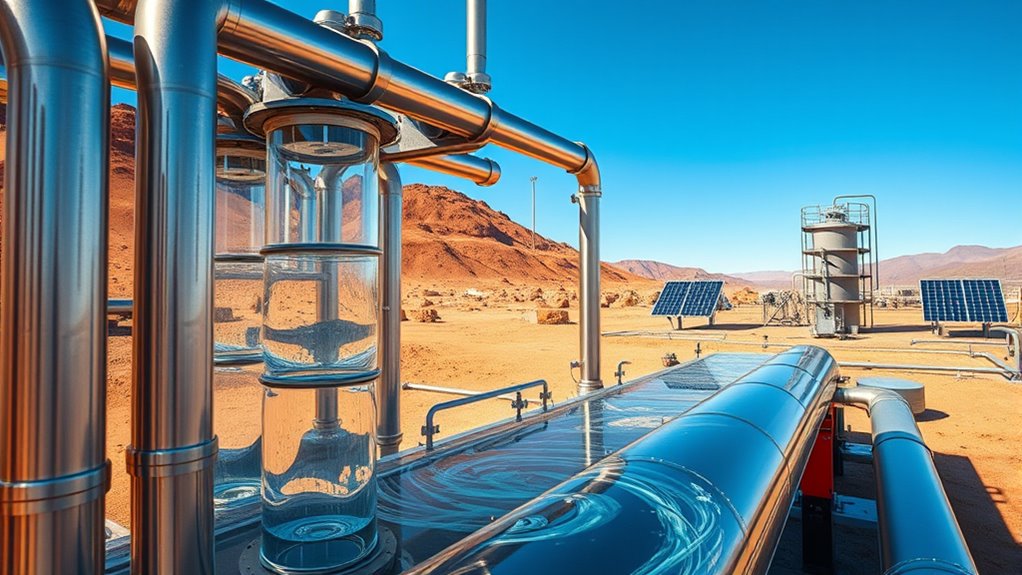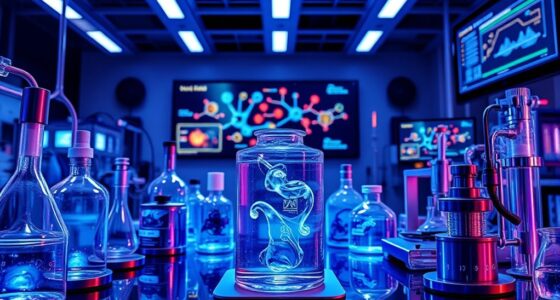As water scarcity increases, the chemical industry faces supply challenges and higher costs. To address this, innovative water treatment technologies like reverse osmosis, ultrafiltration, nanotechnology, and biological filtration are transforming how companies reuse and purify water efficiently. Sustainable practices such as wastewater recycling and eco-friendly chemicals help reduce freshwater reliance. Strategic collaborations and policy support are also driving progress. To understand these groundbreaking solutions and how they’re shaping the industry’s future, keep exploring further.
Key Takeaways
- Advanced filtration methods like nanocomposite membranes and ultrafiltration enable efficient removal of contaminants, reducing water use in chemical processes.
- Adoption of eco-friendly chemicals and biological treatments minimizes environmental impact and water pollution from chemical industry effluents.
- Wastewater recycling and reuse technologies, including reverse osmosis and membrane bioreactors, help conserve freshwater resources amid scarcity.
- Industry innovations such as AI-driven monitoring and green chemicals optimize water management, enhancing sustainability and operational resilience.
- Collaborative efforts and policy incentives promote adoption of green technologies, supporting sustainable water treatment in the chemical sector.
The Growing Challenge of Water Scarcity in Chemical Manufacturing
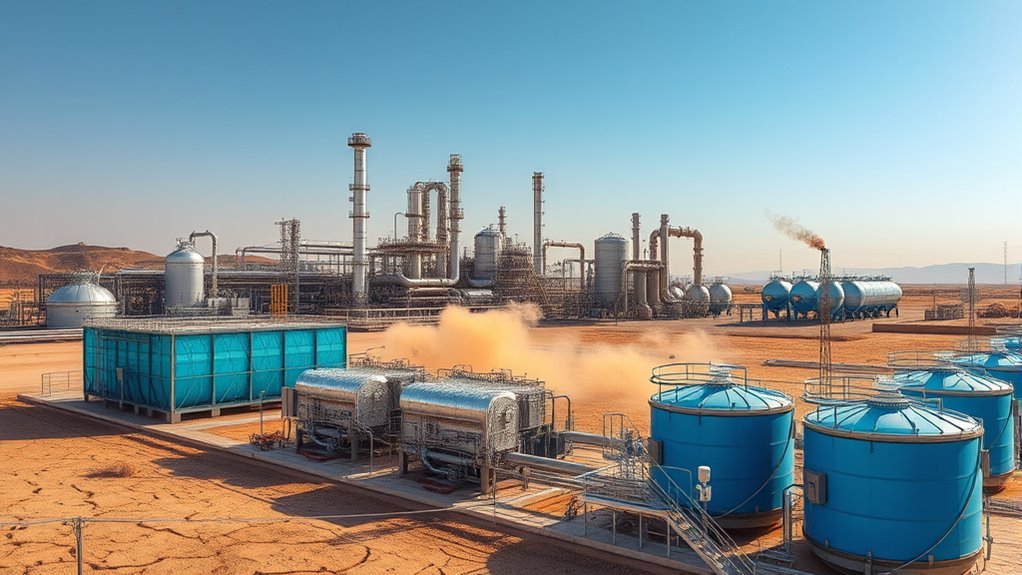
Water scarcity is becoming an increasingly urgent challenge for the chemical manufacturing industry. As water demand is projected to increase by 400% by 2050, you’ll face mounting pressure to secure reliable supplies.
Water scarcity threatens chemical manufacturers’ supply reliability amid rising demand.
Water stress hampers your ability to maintain production levels and threatens long-term sustainability. Despite efforts toward sustainability, water availability remains a critical concern, pushing operational costs higher and risking disruptions. Color accuracy, which influences water treatment processes, can be affected by changes in water quality and source variability.
Droughts can lead to supply shortages, forcing you to adjust schedules or modify processes to conserve water. This situation demands innovative strategies, such as enhanced water recycling and sourcing from desalination or groundwater, to ensure ongoing operations.
Water scarcity leads to operational disruptions, including complete plant shutdowns. This can significantly increase costs and cause delays in product delivery, impacting your company’s reputation and profitability.
Addressing these challenges is essential for your company’s competitiveness and environmental responsibility in an increasingly water-scarce world.
Water Use and Its Impact on Industry Operations

Understanding how water is utilized in chemical industry operations is essential because it directly influences your production processes and overall efficiency. Most water is used for heating and cooling, with over 90% dedicated to cooling processes. As a result, your operations depend heavily on water availability, especially in water-intensive sectors like organic chemicals manufacturing. The European industry accounts for a significant share of freshwater use, which can strain local resources. Water consumption impacts energy use; heating and cooling require substantial energy, raising costs and environmental concerns. To mitigate these effects, many plants recycle and reuse water, reducing freshwater needs. Efficient water management not only minimizes environmental impact but also helps maintain uninterrupted operations amid water scarcity challenges. Water is utilized for heating, cooling, vacuum creation, steam, solvents, rinsing, distillation, transport, and washing, highlighting its crucial role across multiple facets of chemical manufacturing. Additionally, implementing innovative water treatment technologies can further optimize water use and reduce waste.
Cutting-Edge Technologies Transforming Water Treatment

Advancements in water treatment technologies are transforming how the chemical industry manages its water resources, enabling more efficient and sustainable operations. Reverse osmosis systems now effectively remove dissolved salts and impurities, while UV treatment eliminates microbial contaminants with quick, chemical-free processes.
Nanotechnology plays a pivotal role, with nanomaterials and nanomembranes offering molecular-level impurity removal and high selectivity. Membrane filtration technologies like high-pressure systems and advanced ceramic filters enhance contaminant removal and durability.
Cutting-edge filtration methods, such as granular activated carbon and ion exchange resins, improve water quality by removing organics and inorganic ions. Emerging innovations like advanced oxidation processes break down complex pollutants, and integration of artificial intelligence optimizes plant efficiency. These innovations are driven by ongoing research and development in the field.
The implementation of real-time monitoring systems ensures continuous quality control, further enhancing treatment effectiveness. These technologies collectively enable industry leaders to treat water more effectively, reducing waste and conserving resources.
Sustainable Practices and Innovative Recycling Solutions

Sustainable practices and innovative recycling solutions are transforming how the chemical industry manages its water resources, emphasizing environmental responsibility and operational efficiency. You can adopt bio-organic flocculants like Zeoturb Liquid, which offer eco-friendly alternatives to traditional chemicals involving alum, iron salts, chlorine, or ozone.
Advanced filtration systems such as ultrafiltration and reverse osmosis support sustainable tertiary water treatment, reducing hazardous chemical use.
Utilize ultrafiltration and reverse osmosis for eco-friendly tertiary water treatment and decreased chemical reliance.
Recycling wastewater is vital, especially in drought-prone regions, helping your operations cut water intake and lower discharge impacts.
Additionally, implementing lower-temperature reactions and reducing catalyst residuals minimize contaminants in wastewater.
To ensure security and compliance, integrating robust cybersecurity measures into your water treatment systems can protect against cyber threats and data breaches.
Overcoming Barriers to Water Management Advancements
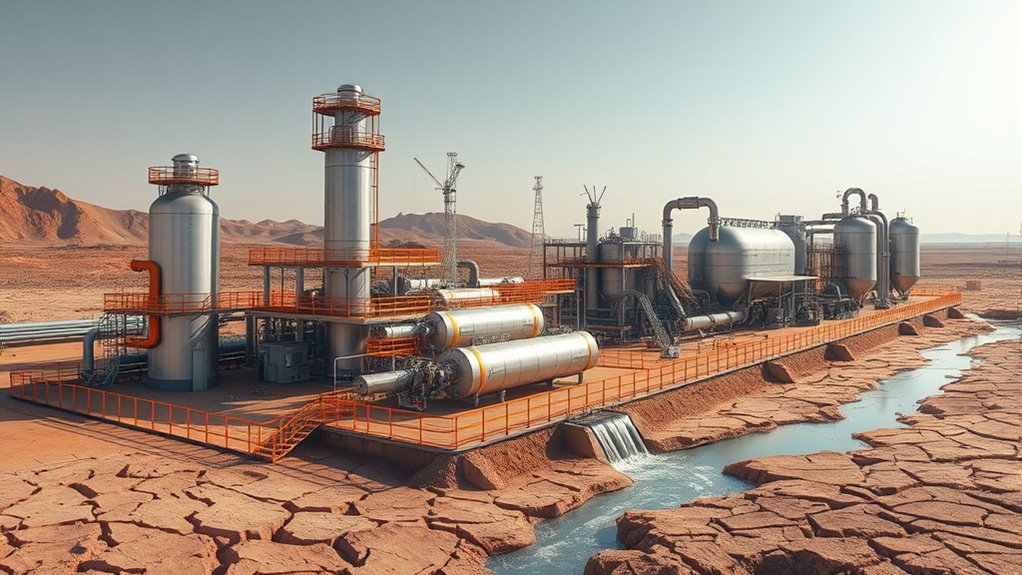
While innovative recycling solutions and sustainable practices are making headway, implementing new water management technologies often hits significant hurdles. Regulatory frameworks differ widely by region, complicating cross-industry reuse efforts.
High upfront costs for advanced treatments like reverse osmosis or membrane bioreactors limit adoption. The financial returns from water reuse can take years, discouraging investment, and historically, the chemical industry focused more on greenhouse gases and waste reduction than water.
Technologically, complex wastewater requires multi-barrier treatment, and scaling membrane systems remains costly and challenging. Additionally, integrating fluctuating water qualities demands real-time monitoring, increasing operational complexity and energy use.
Supply chain disruptions for treatment chemicals and water source degradation further threaten continuous operation. Overcoming these barriers requires targeted investments, cross-sector collaboration, and adaptable, innovative solutions.
Furthermore, understanding water treatment processes is essential for developing effective and sustainable water management strategies.
Strategic Approaches to Ensuring Water Security
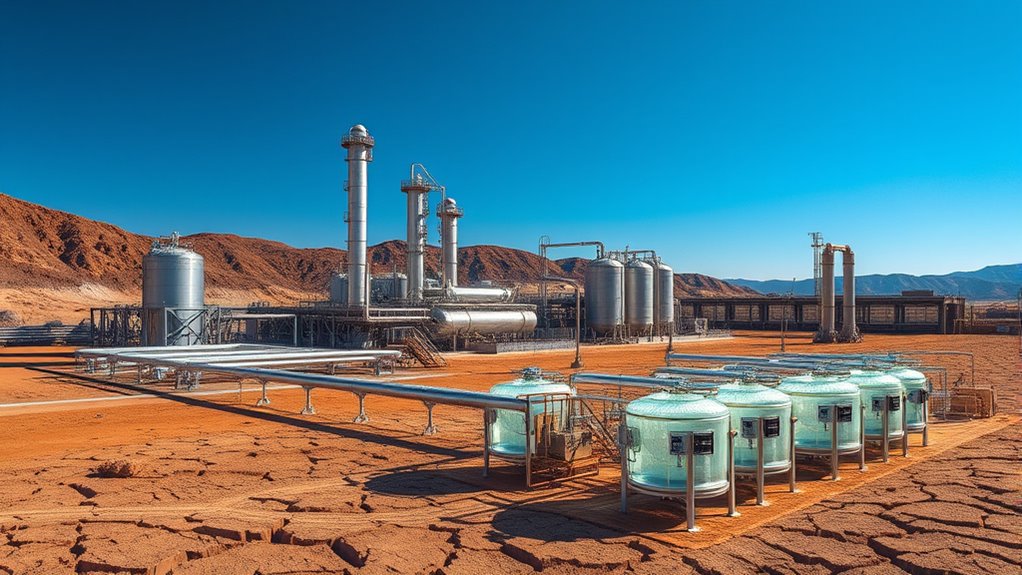
To effectively guarantee water security in the chemical industry, you need to adopt thorough, system-wide strategies that tackle risks from multiple angles. Focus on integrated water risk mitigation by conducting comprehensive assessments that consider climate change, regulations, and demand shifts. Incorporate conflict resolution skills into stakeholder engagement to address disputes and foster collaboration effectively, ensuring cohesive action toward water management goals. Use interdisciplinary research to develop adaptive, resilient water management solutions that reduce vulnerabilities related to scarcity, contamination, and supply disruptions. Promote collective action among stakeholders to strengthen mitigation efforts and ensure lasting impacts. Implement policies that curb waste, encourage efficient water use, and incentivize advanced treatment technologies. Optimize process water recycling and reuse, adopting innovative chemical treatments to minimize freshwater withdrawals. Strengthen governance by building institutional capacity and fostering coordination across sectors. These strategic approaches ensure sustainable water security for the chemical industry and surrounding communities.
Forward-Looking Trends and Collaborative Efforts in Water Innovation
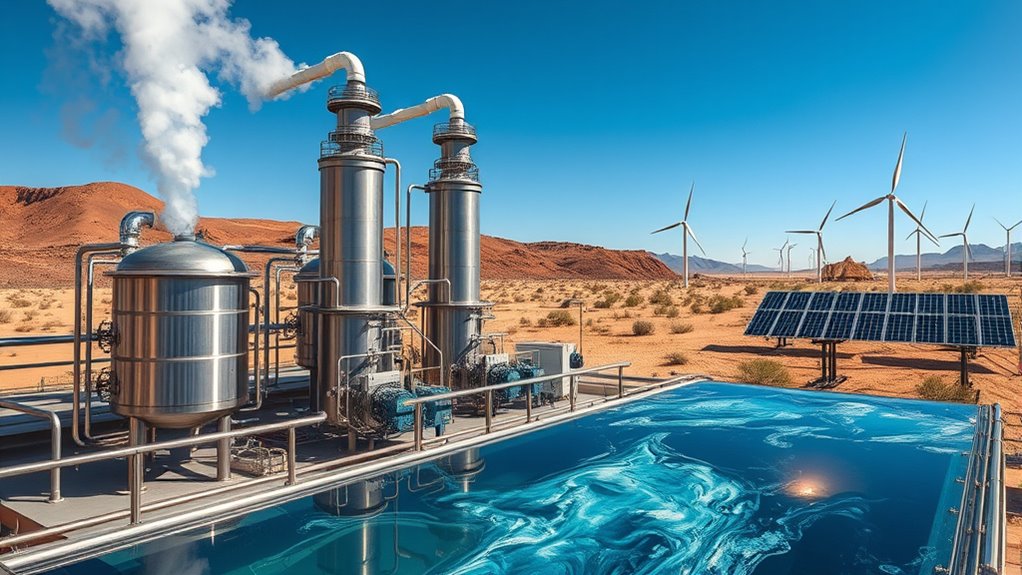
Innovations in water treatment are shaping the future of water security within the chemical industry. You’ll see advancements like carbon-based materials such as activated carbon and graphene, which enhance purification through adsorption.
Advanced filtration systems, including nanocomposite membranes, improve efficiency by better targeting chemical contaminants. Biological filtration uses bacteria to purify water and generate electricity, while membrane bioreactors like WarraniumMBR deliver high-quality water for drinking and irrigation.
Green and biodegradable chemicals are gaining traction to reduce environmental impact. Industry collaborations, including research partnerships, startup involvement, and international cooperation, accelerate innovation.
Emerging trends like smart sensors, desalination, wastewater reuse, and green technologies further enhance efficiency and sustainability. These combined efforts help ensure water security, support economic growth, and mitigate global water stress. Efficient water treatment methods are critical for addressing the increasing challenges posed by water scarcity worldwide.
Frequently Asked Questions
How Do Water Scarcity Issues Vary Across Different Regions of the Chemical Industry?
You see that water scarcity issues differ across regions. In Africa, mining worsens water stress, while Asia faces shortages impacting plant operations.
The Middle East relies on costly desalination due to arid conditions, and Latin America experiences droughts causing shutdowns.
High water costs, regional regulations, and technological advances shape how chemical companies adapt, often leading to innovations like recycling, process changes, and alternative sources to manage water use effectively.
What Are the Economic Impacts of Adopting Advanced Water Treatment Technologies?
You should know that adopting advanced water treatment technologies can notably boost your industry’s profitability. Despite higher initial costs, these systems lead to lower operational expenses, resource recovery, and improved compliance with environmental standards.
For example, they can help generate revenue by selling treated wastewater and reduce public health costs, which total around $260 billion annually worldwide.
Over time, these benefits outweigh the upfront investments, making sustainability a smart economic move.
How Can Small Chemical Manufacturers Implement Sustainable Water Practices Effectively?
You can implement sustainable water practices effectively by starting with water reuse systems to cut consumption and using efficient treatment chemicals to reduce environmental impact.
Engage your employees through training programs and involve them in water-saving initiatives.
Use monitoring tools like data tracking and CIP circuit instrumentation to identify areas for improvement.
Collaborate with industry peers, report your progress publicly, and stay updated on innovative water technologies to continually enhance your sustainability efforts.
What Role Do Government Policies Play in Promoting Water Innovation in Chemicals?
Think of government policies as the compass guiding innovation. They set the direction by establishing standards for water safety, like PFAS regulations, and offering funding through grants and bonds.
These policies encourage your industry to adopt new water treatment technologies, collaborate with research institutions, and improve infrastructure. Your role is to leverage these incentives, ensuring your practices are sustainable and compliant.
Ultimately, these efforts can transform challenges into opportunities for cleaner, safer water.
How Do Public Perceptions Influence Water Management Strategies in the Chemical Sector?
Public perceptions shape water management strategies by highlighting community concerns about chemical contamination and wastewater pollution. Your awareness and attitudes push companies and policymakers to prioritize safer practices, adopt innovative treatment technologies, and enforce stricter regulations.
When you express concerns or support for environmental safety, you help influence industry practices, encouraging transparency and accountability. This collective voice guarantees that water management approaches align with public expectations, fostering trust and promoting sustainable chemical industry operations.
Conclusion
Just as Pandora’s box once unleashed unforeseen challenges, embracing innovative water treatment transforms the future of the chemical industry. By adopting sustainable practices and cutting-edge technologies, you can turn the tide against water scarcity. Collaborate and innovate, much like explorers charting new waters, to secure your operations and protect our shared resource. The path forward is clear—through ingenuity and partnership, you can navigate toward a more resilient and water-wise industry.
